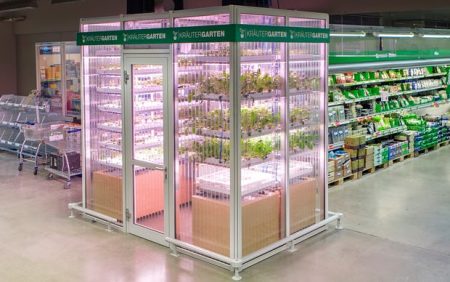July 3, 2017 – Professor Dickson Despommier of Columbia University, whose work on vertical farms has made him a primary advocate of urban agriculture as part of a solution to deal with both food security and climate change, proposes that every city on Earth produce 10% of its food needs indoors. He goes on stating “it would allow us to take 340,000 square miles [almost 881,000 square kilometers] of farmland back to forest. That, in turn, could absorb enough carbon dioxide to bring the level in Earth’s atmosphere back to where it was in 1980.” Despommier points to world population forecasts that indicate almost 80% of the world’s population will be urban by 2050 and that there will conservatively be another 3 billion of us to feed. The challenge, therefore, is to find new ways and technologies to produce food. We can cut down forests and use the land to grow food crops. Or we can preserve those forests as natural carbon sinks and, instead, raise crops indoors.
The production of food on this planet is a significant contributor to carbon emissions. In their book, “Climate of Hope,” authors Michael Bloomberg and Carl Pope describe our need to eat as a big deal when talking about climate change. They write “if you add up everything – growing crops, clearing and cultivating land, producing and applying fertilizers, shipping food to customers and keeping it refrigerated until it is eaten – food is responsible for about one-third of the total greenhouse emissions each year.” Agriculture produces 30% of the total methane released annually into the atmosphere. Blame cows and rice paddies. The former excreting the equivalent of 2 billion tons of carbon dioxide (CO2) annually. The latter generates 700 million tons. And those numbers are only part of the problem. Add to this nitrous oxide emissions, another potent greenhouse gas, from excessive use of fertilizers. And then top it off with the widespread use of plowing rather than no-till practices on the majority of farms, with the resulting release of carbon, normally bound in soil and root systems, into the atmosphere where it contributes to global warming.
Knowing that our need to eat is a big deal for climate change, a new start-up company, InFarm, is converting urban indoors spaces into vertical farms. The company website proudly proclaims, “we are the new farmers and the city is our farm.” Located in Berlin, the goal is to deliver on-demand farm produce within cities by introducing the technology to grocery stores. Shoppers will literally pick their food.
The InFarm vertical farming modular system can grow herbs, lettuce, other vegetables, and fruit. Its modularity makes it scalable based on available in-store floor space. A small store could handle 10 to 100 modules. A larger store 100 to 1,000. Online grocery systems could have warehouse operations filled with living plants that could be picked daily and delivered to urban consumers.
The company is partnering with supermarket chains like Metro Cash & Carry. At its stores, the modules are providing a “perpetual daily harvest” using a rotating series of growing trays. New plantings go to the back and mature plants to the front where they can be picked and purchased.
InFarm has loaded their system with sensors that monitor the health of the plants throughout their lifecycle. Machine learning anticipates potential problems with every new plant type introduced coming with its own set of algorithms that factor in all the conditions for optimal health.









